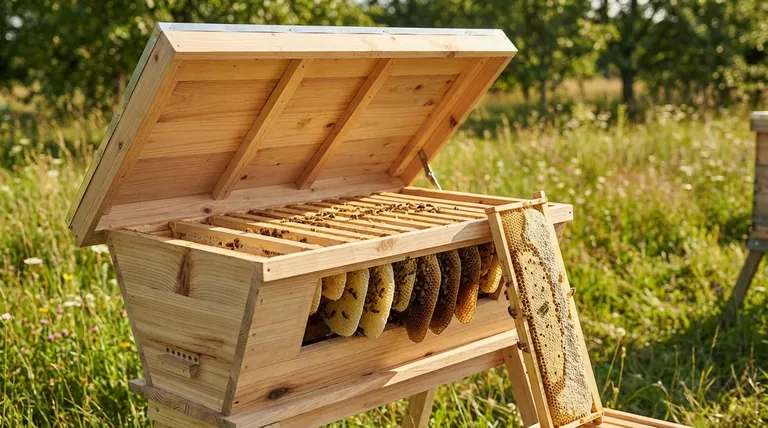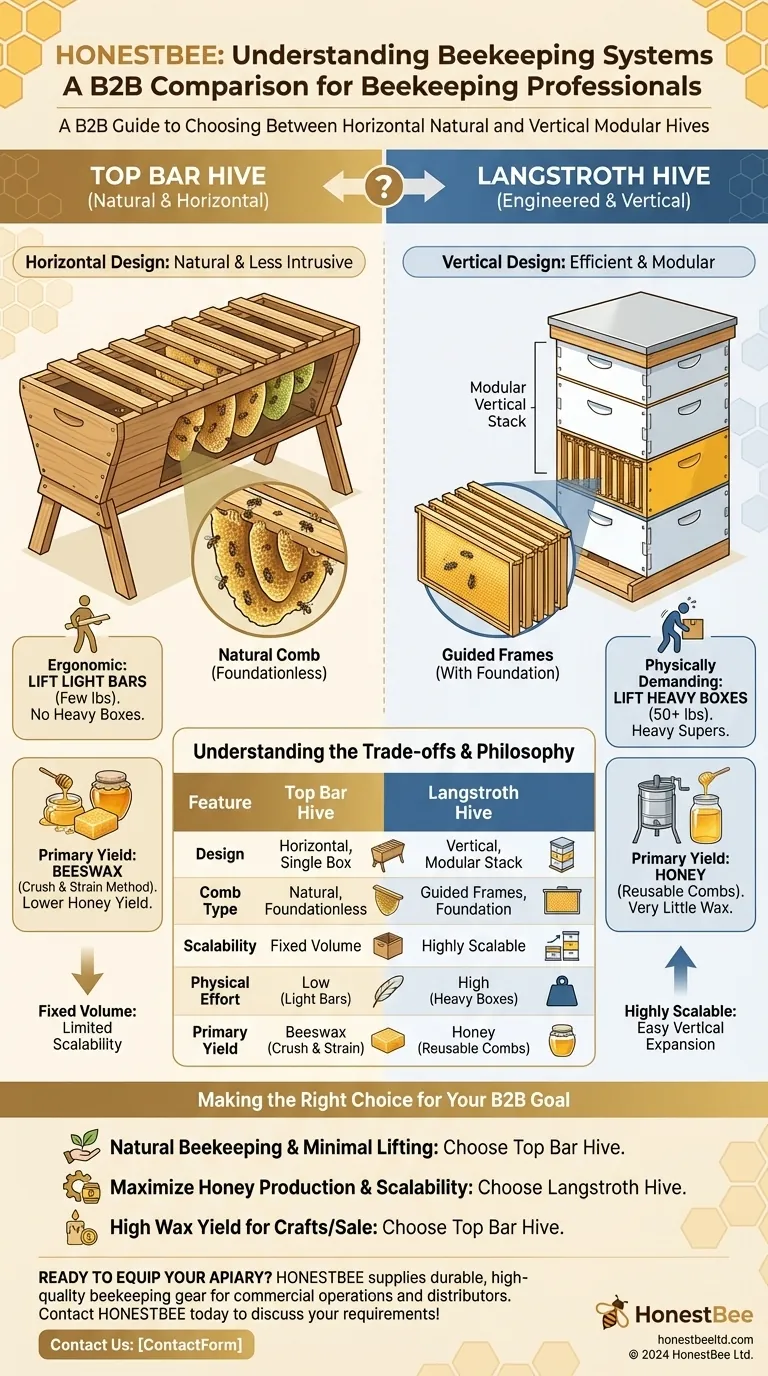While the question compares a hive component to a roof, the core difference lies in the fundamental design philosophy between a Top Bar Hive and a Langstroth Hive. A Top Bar Hive is a horizontal system where bees build comb naturally downwards from simple bars. In contrast, a Langstroth Hive is a vertical, modular system using rectangular frames that guide comb construction and allow for vertical expansion.
The choice isn't about comparing individual parts like top bars and roofs, but about understanding two distinct approaches to beekeeping. The Top Bar Hive prioritizes a more natural, less intrusive process, while the Langstroth Hive is engineered for honey production efficiency and scalability.

The Core Difference: Horizontal vs. Vertical Design
The most immediate distinction between these two hives is their orientation and structure. This single design choice dictates how you manage the colony, inspect it, and harvest from it.
The Top Bar Hive: A Single, Horizontal Trough
A Top Bar Hive is a single, long box that sits horizontally on legs. This design eliminates the need for heavy lifting, as you never have to move entire boxes full of honey.
The bees build their comb downwards from a series of individual bars—the "top bars"—that are laid across the top of the trough.
The Langstroth Hive: A Modular, Vertical Stack
The Langstroth is the most recognizable beehive, consisting of a vertical stack of modular boxes. The bottom boxes are for the brood (the queen and developing bees), and additional boxes, called "supers," are added on top for honey storage.
This vertical design allows the hive to be easily expanded as the colony grows, but it requires lifting heavy boxes that can weigh 50 pounds or more.
Inside the Hive: Natural Comb vs. Guided Frames
The internal components of each hive reflect their core philosophy. One mimics a hollow log, while the other provides a structured, reusable system.
Top Bars and Natural Comb
In a Top Bar Hive, the bees build their comb entirely on their own, drawing it down from the simple wooden bars. This is often called natural comb or foundationless beekeeping.
The comb is only attached to the wooden bar at the top, making it more fragile but allowing bees to determine their own cell size and spacing.
Langstroth Frames and Foundation
A Langstroth hive uses four-sided wooden frames. Beekeepers often install a sheet of foundation (wax or plastic) inside the frame, which provides a guide for the bees.
This system creates uniform, straight combs that are supported on all four sides, making them very durable and easy to handle during inspections and honey extraction.
Understanding the Trade-offs
Neither system is inherently superior; they are simply designed for different goals and management styles. Choosing between them involves weighing their respective advantages and disadvantages.
Scalability and Expansion
The Langstroth hive's greatest strength is its scalability. As the colony expands and brings in more nectar, you simply add more boxes.
A Top Bar Hive has a fixed volume. While this is often sufficient, a very strong colony can run out of space, which may increase its natural tendency to swarm if not managed carefully.
Physical Effort
The Top Bar Hive is the clear winner for ergonomics. Inspections involve lifting one bar at a time, which weighs only a few pounds.
Managing a Langstroth hive requires lifting heavy supers full of honey, making it more physically demanding.
Honey and Wax Yield
Harvesting from a Top Bar Hive involves cutting the entire comb off the bar. The honey is then separated by crushing and straining the comb, which produces a large amount of beeswax.
With a Langstroth, only the wax cappings are removed. The honey is spun out in an extractor, and the empty comb (the "drawn comb") is returned to the hive. This saves the bees immense energy and leads to higher honey yields over time, but produces very little wax.
Making the Right Choice for Your Beekeeping Goal
Your beekeeping philosophy and physical capabilities should guide your decision.
- If your primary focus is natural beekeeping and minimal heavy lifting: The Top Bar Hive is the ideal choice, as it promotes natural comb building and is ergonomically friendly.
- If your primary focus is maximizing honey production and scalability: The Langstroth Hive is the industry standard for its efficiency, expandability, and reusable combs.
- If you are interested in a high wax yield for crafts or sale: The Top Bar Hive's crush-and-strain harvesting method will provide significantly more beeswax.
Ultimately, understanding these core design philosophies—not just individual components—is the key to choosing the hive that best suits your personal beekeeping journey.
Summary Table:
| Feature | Top Bar Hive | Langstroth Hive |
|---|---|---|
| Design | Horizontal, single box | Vertical, modular stack |
| Comb Type | Natural, foundationless | Guided frames with foundation |
| Scalability | Fixed volume | Highly scalable |
| Physical Effort | Low (light bars) | High (heavy boxes) |
| Primary Yield | Beeswax (crush & strain) | Honey (reusable combs) |
Ready to equip your apiary with the right hive system?
Whether you manage a large commercial operation or supply equipment to distributors, choosing the correct hive is critical for efficiency and yield. HONESTBEE supplies durable, high-quality beekeeping supplies and equipment tailored for commercial apiaries and beekeeping equipment distributors.
Our wholesale-focused operations ensure you get the reliable gear you need to succeed.
Contact HONESTBEE today to discuss your hive and equipment requirements!
Visual Guide

Related Products
- Top Bar Beehive for Beekeeping Wholesales Kenya Top Bar Hive
- Long Langstroth Style Horizontal Top Bar Hive for Wholesale
- HONESTBEE Professional Long Handled Hive Tool with Precision Cutting Blade
- HONESTBEE Advanced Ergonomic Stainless Steel Hive Tool for Beekeeping
- HONESTBEE Professional Multi-Functional Hive Tool with Ergonomic Wood Handle
People Also Ask
- How is honey harvested from a top-bar hive? A Guide to Simple, Low-Equipment Processing
- What are the benefits of a top bar hive? A Natural, Low-Impact Approach to Beekeeping
- What is the quickest method to harvest honey from a top bar hive? A Guide to the Simple 'Cut and Crush' Method
- What are the labor requirements for a KTBH vs. Langstroth hive? A Guide for Apiary Efficiency
- Why are hive inspections easier with Top Bar Hives? Achieve a Calmer, Safer Approach to Beekeeping



















